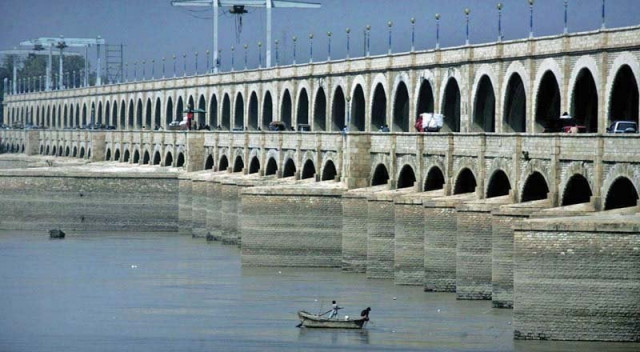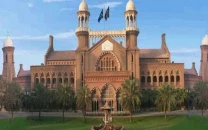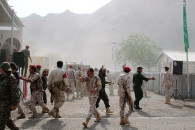World Bank agrees to finance rehabilitation of Sukkur Barrage
PC-I of project will be submitted within 15 days, say planning and development chairperson and irrigation secretary

The Sukkur Barrage is one of the three major barrages located in Sindh. PHOTO: FILE
The decision was taken on Tuesday in a meeting held between Chief Minister (CM) Murad Ali Shah and a 14-member World Bank delegation headed by Country Director Patchamuthu Illangovan.
The CM said a feasibility study for the rehabilitation of the Sukkur Barrage had been conducted which was later reviewed by World Bank officials, including its experts in dam design, sedimentation and structures. A public hearing was also held to assess the project's environmental impact, he added.
Sharing details of the assessment's findings, the CM said the barrage structure had been declared safe and rehabilitation works could extend its life indefinitely. He added that results of some additional studies would also be implemented in the rehabilitation work, which would increase the barrage's flood handling capacity to 1.5 million cusecs.
SCA chides irrigation officials for closure of Rohri Canal
The rehabilitation project would be carried out over a period of four years, the CM said. Under the project, repair of RCC arches, stone arches of head regulators, stone piers, and stone filling above the arches would be carried out, whereas, gate deck flooring, barrage road surface and storm water drainage system would be replaced. The project also includes increasing the height of the existing left pocket divide walls. De-silting of canals would also be carried out under the project.
As per the recommendations of the feasibility report, the electric system of the barrage will be completely replaced, including switchboards, local control panels, feeding from Water and Power Development Authority's grid station, 11-kilovolt transformer and standby generators.
The project would cost around Rs16.26 billion, the CM said. Sharing the cost's distribution, the CM said repair works would cost around Rs1.06 billion and replenishment of scour protection works would be carried out at around Rs571.5 million. Foundation inspection and repairs would cost Rs1.97 million, building works Rs356.3 million, monitoring and control instrumentation Rs238.2 million, gates and mechanical works and procurement Rs3.34 billion, electrical works Rs634.2 million and insurance, client and engineers facilities would cost Rs524.9 million. Additional studies would also be carried out at an estimated cost of Rs682 million and project management and physical contingencies and price escalation is estimated at Rs2.12 billion.
The World Bank country director urged the CM to submit PC-I of the project so that it could be formally approved. Planning and Development Chairperson Mohammad Waseem and Irrigation Secretary Jamal Shah said the PC-I of the project was about to be finalised and it would be submitted within 15 days.
'Drip irrigation system helps save water, increases yield'
The CM was assisted by Home Minister Sohail Anwar Siyal, Local Government Minister Jam Khan Shoro, Population Welfare Minister Mumtaz Jakharnai, Principal Secretary to the CM Sohail Rajput, Schools Education Secretary Iqbal Durani, Health Secretary Dr Fazlullah Pechuho, Population Secretary Laiq Ahmed and others.
The Sukkur Barrage was formally called Lloyd Barrage. Built by the British government on the Indus River, the barrage controls one of the largest irrigation systems in the world. It was designed by Sir Arnold Musto KCIE, and constructed under the overall direction of Sir Charlton Harrison, KCIE, as chief engineer. Construction of the barrage commenced in 1923 and it was completed in January, 1932. Some of the barrage's canals are larger than the Suez Canal. Later, two more major barrages were constructed in Sindh, which were Kotri and Guddu barrages. Irrigation in Sindh is largely controlled by these three barrages.
Sukkur Barrage was responsible for bringing large-scale awakening in Sindh as a consequence of economic benefits. A large number of students from rural areas turned up in the cities for education, immediately after the barrage became functional. Considering its significance, the Sukkur Barrage should be preserved. Moreover, efforts should be made to ensure its operation as per irrigation rules since any mismanagement of the barrage will have serious repercussions on the economy of Sindh.



















COMMENTS
Comments are moderated and generally will be posted if they are on-topic and not abusive.
For more information, please see our Comments FAQ